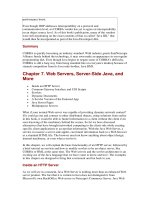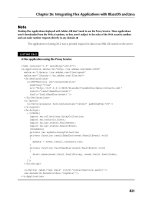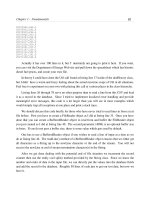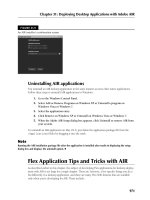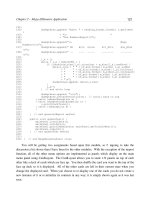Java and Flex Integration Bible potx
Bạn đang xem bản rút gọn của tài liệu. Xem và tải ngay bản đầy đủ của tài liệu tại đây (17.24 MB, 555 trang )
Shelving Category:
COMPUTERS / Internet /
Web Page Design
Reader Level:
Beginning to Advanced
$44.99 USA
$53.99 Canada
Integrate Java and Flex
for dynamic applications
Make your Web
applications rich
Build a chat client
or a storefront
Keefe
Christiansen
The book you need to succeed!
Marry Java and Flex to live happily
ever after in Web development bliss
Whether you’re a designer who wants to master
programming or a creative developer seeking to broaden
your skills beyond coding, now you have two powerful
tools and a valuable guide to get you there. anks to
the step-by-step instructions and practical examples
in this in-depth book, you’ll quickly get up to speed on
relational databases, learn the ins and outs of Java and
Flex, and discover the art and science of mashups by
mixing code and graphics to create custom interfaces.
• Set up the Java development environment and confi gure Flex
• Send data from Flex and start writing Java Web applications
• Create a storefront server application with Java
• Develop a storefront client application with Flex
• Connect Java and Flex to create a real-time messaging system
• Confi gure Cascading Style Sheets for custom interfaces
• Master advanced concepts, including enterprise-level development
Java
®
and Flex
®
Integration
Matthew Keefe
is a new-media designer and
developer with a strong background
in application development for the
Web and offl ine. Matt is the author
of the Flash and PHP Bible.
Charles A.
Christiansen Jr.
is a senior software engineer who
currently uses Java and Flex 3.
Charles has written applications
that run the gamut — from heavy
client Java applications that use
RMI over dialup to fast, lightweight
Web applications that use Spring
and Hibernate.
Spine: 1.104"
Matthew Keefe and Charles A. Christiansen Jr.
Java
®
and Flex
®
Integration
Learn how to connect Java and Flex to build real-world applications
www.it-ebooks.info
www.it-ebooks.info
Java
®
and Flex
®
Integration Bible
www.it-ebooks.info
www.it-ebooks.info
Java
®
and Flex
®
Integration Bible
Matthew Keefe and
Charles A. Christiansen Jr.
www.it-ebooks.info
Java
®
and Flex
®
Integration Bible
Published by
Wiley Publishing, Inc.
10475 Crosspoint Boulevard
Indianapolis, IN 46256
www.wiley.com
Copyright © 2009 by Wiley Publishing, Inc., Indianapolis, Indiana
Published by Wiley Publishing, Inc., Indianapolis, Indiana
Published simultaneously in Canada
ISBN: 978-0-470-40074-6
Manufactured in the United States of America
10 9 8 7 6 5 4 3 2 1
No part of this publication may be reproduced, stored in a retrieval system or transmitted in any form or by any means,
electronic, mechanical, photocopying, recording, scanning or otherwise, except as permitted under Sections 107 or 108 of
the 1976 United States Copyright Act, without either the prior written permission of the Publisher, or authorization
through payment of the appropriate per-copy fee to the Copyright Clearance Center, 222 Rosewood Drive, Danvers, MA
01923, (978) 750-8400, fax (978) 646-8600. Requests to the Publisher for permission should be addressed to the
Permissions Department, John Wiley & Sons, Inc., 111 River Street, Hoboken, NJ 07030, 201-748-6011, fax 201-748-
6008, or online at
/>Limit of Liability/Disclaimer of Warranty: The publisher and the author make no representations or warranties with
respect to the accuracy or completeness of the contents of this work and specifically disclaim all warranties, including
without limitation warranties of fitness for a particular purpose. No warranty may be created or extended by sales or
promotional materials. The advice and strategies contained herein may not be suitable for every situation. This work is sold
with the understanding that the publisher is not engaged in rendering legal, accounting, or other professional services. If
professional assistance is required, the services of a competent professional person should be sought. Neither the publisher
nor the author shall be liable for damages arising herefrom. The fact that an organization or Website is referred to in this
work as a citation and/or a potential source of further information does not mean that the author or the publisher endorses
the information the organization or Website may provide or recommendations it may make. Further, readers should be
aware that Internet Websites listed in this work may have changed or disappeared between when this work was written
and when it is read.
For general information on our other products and services or to obtain technical support, please contact our Customer
Care Department within the U.S. at (800) 762-2974, outside the U.S. at (317) 572-3993 or fax (317) 572-4002.
Library of Congress Control Number: 2009920909
Trademarks: Wiley, the Wiley logo, and related trade dress are trademarks or registered trademarks of John Wiley &
Sons, Inc. and/or its affiliates, in the United States and other countries, and may not be used without written permission.
Java is a registered trademark of Sun Microsystems, Inc. Flex is a registered trademark of Adobe Systems Incorporated. All
other trademarks are the property of their respective owners. Wiley Publishing, Inc., is not associated with any product or
vendor mentioned in this book.
Wiley also publishes its books in a variety of electronic formats. Some content that appears in print may not be available in
electronic books.
www.it-ebooks.info
In memory of my best friend, Andrew Lenihan.
To Eileen, for all your love and support;
and to my mom, who always wanted to see my name in print.
www.it-ebooks.info
About the Authors
Charles A. Christiansen Jr. is a full-time Java application developer. Over the past 11 years, he
has worked on teams that have developed a wide variety of e-learning and classroom management
applications. Charles has written applications by using the gamut of Java application technologies,
from the heavy client Java application using RMI over dialup connections to fast, lightweight Web
applications using Spring and Hibernate. He holds a Master of Science degree in Internet
Engineering from the Graduate Center of Marlboro College.
Charles lives in the metro Boston area with his wife Eileen and their irascible cat Tigger. In his
spare time, he enjoys cooking, especially barbecue, and photography.
Matthew Keefe is a new-media designer, developer, author, and trainer with a strong background
in application development for the Web and offline platforms. Originally a full-time graphic artist,
he found that much of the programming associated with his design work was being outsourced.
Matthew quickly learned programming for the Web and uncovered a valuable but little-known
skill set in this industry: the ability to build a site and to also powerfully design it.
Matthew recently authored the Flash and PHP Bible, has contributed to various Flex and Flash
magazines, and runs
for other programmers to learn from.
You can find more information on his personal site at
.
Matthew has worked with several companies and studios, including Inverted Creative, Delphi,
PhotoshopCAFE, Kineticz Interactive, Organi Studios, Bent 360, and ORCA Media, Inc. He lives in
Carver, Massachusetts.
www.it-ebooks.info
Credits
Acquisitions Editor
Courtney Allen
Project Editor
Christopher Stolle
Technical Editor
Darron Schall and Gerry Power
Copy Editor
Marylouise Wiack
Editorial Manager
Robyn Siesky
Business Manager
Amy Knies
Senior Marketing Manager
Sandy Smith
Vice President and Executive Group
Publisher
Richard Swadley
Vice President and Executive Publisher
Barry Pruett
Project Coordinator
Lynsey Stanford
Graphics and Production Specialists
Ana Carrillo
Jennifer Mayberry
Sarah Philippart
Quality Control Technicians
Laura Albert
Amanda Graham
Proofreading
Kathy Simpson
Indexing
Sharon Shock
www.it-ebooks.info
www.it-ebooks.info
ix
Acknowledgments xvii
Introduction xix
Part I: Installation and Getting Started . . . . . . . . . . . . . . . . . . .1
Chapter 1: Setting Up the Java Development Environment 3
Chapter 2: Configuring Flex for Java Development 37
Chapter 3: Similarities between Java and Flex 61
Chapter 4: Understanding the Flex Application Development Process 85
Part II: Connecting Java and Flex . . . . . . . . . . . . . . . . . . . . . 111
Chapter 5: Sending Data from Flex 113
Chapter 6: Writing Java Web Applications 123
Chapter 7: Using JUnit and FlexUnit to Test Your Applications 167
Chapter 8: Relational Databases 203
Chapter 9: Java and Databases 233
Chapter 10: Building a Basic Database-Powered Flex Application 265
Chapter 11: Developing a Stock Ticker with BlazeDS 285
Part III: Building Advanced Applications . . . . . . . . . . . . . . . 305
Chapter 12: Developing a Storefront Server Application with Java 307
Chapter 13: Developing a Storefront Server Application with Flex 371
Chapter 14: Building a Real-Time Messaging System 399
Chapter 15: Extending Java and Flex Development 435
Chapter 16: Advanced Development 477
Appendix: Installing Adobe Flex and Adobe Flex Builder 499
Glossary 509
Index 513
www.it-ebooks.info
www.it-ebooks.info
xi
Acknowledgments ......................................... xvii
Introduction .............................................. xix
Part I: Installation and Getting Started 1
Chapter 1: Setting Up the Java Development Environment ............3
The Java Programming Language 3
Object-oriented programming 4
Key Java concepts 4
Java syntax 5
The Java SE Development Kit 7
Installing the JDK 8
Configuring the JDK 11
The JBoss Application Server 14
Installing JBoss 14
Configuring JBoss 14
Apache Ant 17
Installing Apache Ant 18
Configuring Apache Ant 18
The Eclipse Integrated Development Environment 20
Installing the Eclipse IDE 21
Configuring the Eclipse IDE 22
Summary 36
Chapter 2: Configuring Flex for Java Development ................. 37
Configuring Flex 37
The Java and Flex project type 38
The Flex Library project type 46
Testing the Configuration 48
Testing online 48
Reading debug messages 54
Summary 60
Chapter 3: Similarities between Java and Flex ......................61
What Makes Java and Flex Similar? 61
Code structure 62
Libraries 67
Development tools 73
www.it-ebooks.info
xii
Contents
How These Similarities Help with Integration 83
Team building 83
Multiapplication integration 83
Summary 84
Chapter 4: Understanding the Flex Application Development Process ...85
Working with Packages and Classes 85
Packages 85
Classes 86
Extending classes 90
MXML and ActionScript 91
Understanding Events in Flex 93
Data Providers 94
Working with Item Renderers 96
Setting up an item renderer 96
Creating an MXML component file 98
Overriding a value 100
Building a Sample Flex Application 104
Summary 110
Part II: Connecting Java and Flex 111
Chapter 5: Sending Data from Flex ............................. 113
Understanding the Sending Process 113
ActionScript approach 114
Using HTTPService 114
Handling the response of the HTTPService call 115
Writing the Sample Test 116
Building the Flex application 116
Adding the components 116
Aligning the components 117
Adding the ActionScript 118
Summary 122
Chapter 6: Writing Java Web Applications....................... 123
The Model-View-Controller Pattern 123
The Spring Framework 124
Writing a Simple Web Application 126
The project directory structure 126
Creating an Eclipse project 128
Configuring the Eclipse project 130
Writing the Web application 141
Writing the Ant build script 156
Enhancing the Web application 164
Summary 166
www.it-ebooks.info
xiii
Contents
Chapter 7: Using JUnit and FlexUnit to Test Your Applications ....... 167
Working with JUnit 167
Importing the testing library 168
Building the testing suite 177
Working with FlexUnit 188
Using unit testing 188
Configuring FlexUnit 189
Developing the unit test 190
Working with the FlexUnit Runner 197
Summary 201
Chapter 8: Relational Databases ............................... 203
Relational Database Concepts 203
Tables 203
SQL queries 206
Stored procedures 209
The MySQL Database Server 209
Installing and configuring MySQL 209
Creating a simple database in MySQL 218
Summary 231
Chapter 9: Java and Databases................................ 233
Java Database Connectivity 233
Overview of JDBC 233
Using JDBC with MySQL 234
The Hibernate Framework 244
Overview of Hibernate 245
Using Hibernate with MySQL 245
Summary 264
Chapter 10: Building a Basic Database-Powered Flex Application ...... 265
Understanding the Database Application 265
Defining the application 265
File outline 266
Building the Database Application 266
Designing the application 266
Creating the product editor popup 269
Creating the product grid ItemRenderer 272
Developing the Database Communication with Java 273
Building a custom data class 274
Adding the class methods 275
Handling the response from the server 276
Connecting the Database Application 278
Main application code 278
Adding the methods 279
Summary 284
www.it-ebooks.info
xiv
Contents
Chapter 11: Developing a Stock Ticker with BlazeDS ............... 285
Installing BlazeDS 286
Understanding Messaging in Flex 286
Producer and Consumer messaging components 286
Managing the destination service 289
Developing a Stock Ticker Application 290
Setting up the messaging config file 290
Developing the Java back end 291
Building the Flex user interface 295
Setting the J2EE Server options 295
Building the user interface 296
Developing the ActionScript 297
Bindable variables 297
Using the labelFunction 299
Summary 303
Part III: Building Advanced Applications 305
Chapter 12: Developing a Storefront Server Application with Java ..... 307
Application Best Practices 307
Code modularity 308
Separation of interface and implementation 308
Developing the Java 309
The MySQL database 310
The Eclipse project 319
The model layer 329
The data access layer 348
The service layer 355
The Ant build file 365
Deploying and Testing the Web Application 367
Summary 370
Chapter 13: Developing a Storefront Server Application with Flex ..... 371
Designing and Developing the Flex Front End 371
Communicating with the Java back end 372
Developing the product viewer 382
Developing the payment solution 395
Summary 397
Chapter 14: Building a Real-Time Messaging System............... 399
Understanding the Application Process 399
Writing the Java Code 400
Setting up the Eclipse project 400
The chat server 403
www.it-ebooks.info
xv
Contents
Writing the Flex Code 408
Connecting the Java and Flex Pieces 420
The Web application configuration 420
The BlazeDS configuration 421
Configuring Ant and Eclipse to build the application 422
Connecting to the chat server 430
Testing the chat application 431
Summary 433
Chapter 15: Extending Java and Flex Development ................. 435
Building Mashups 435
Libraries for mashups 436
Advanced example 436
Overview of Developing Custom Flex Interfaces 463
Custom interfaces using CSS 463
Custom interfaces using ActionScript 464
Creating the Flex mashup UI 465
Skinning the Flex mashup UI 473
Summary 476
Chapter 16: Advanced Development........................... 477
Advanced Java Concepts 477
Enterprise-level Java development 477
More library components 485
Advanced Flex Concepts 492
Requirements for charting components 492
Configuring the charting component in Flex 493
Summary 498
Appendix: Installing Adobe Flex and Adobe Flex Builder ............ 499
Glossary................................................. 509
Index ................................................... 513
www.it-ebooks.info
www.it-ebooks.info
xvii
Charles A. Christiansen Jr.: I would like to thank Matthew Keefe for asking me to do this book
with him, my lovely wife Eileen for encouraging me through this whole process, Courtney Allen
and Christopher Stolle for being so great to work with, Kevin Polk for bringing me into the world
of Java development so many years ago, and my parents for teaching me the value of hard work
and encouraging me to fully pursue my interests.
Matthew Keefe: I would like to thank all the folks at Wiley for making this book a reality. A spe-
cial thanks to acquisitions editor Courtney Allen and project editor Christopher Stolle. I would
also like to thank my friends and family — Philip, Daz, Colin, Teisha, John, Brooke, Frank, and
my mom — for their support. And lastly, I would like to thank my dad for getting me started in
technology when I was younger and making it possible to do what I love.
www.it-ebooks.info
www.it-ebooks.info
xix
F
or years, Java has been used to develop Web applications that allow users to access server-side
data through user interfaces presented in a Web browser. Generally, the user interfaces for these
applications have been presented to the user as HTML by using technologies such as Java Server
Pages (JSP) to insert server-side data into the user interface to create dynamic, data-driven applications.
Flex offers another possibility for Web application user interfaces — the highly visual, fluid, and
rich experience provided by Adobe Flash Player and Flash movies. Flex puts the richness and
power of Flash into the hands of application developers by providing a software development kit
and user interface components that allow developers to create Flash applications by using familiar
software development tools and methodologies.
When you integrate Java and Flex in a Web application, you get the best of both worlds. You get the
power and stability that Java provides on the server side and the rich, dynamic user interfaces that
Flex and Adobe Flash Player make possible. In this book, you learn to marry the two to create appli-
cations with the data your customers need and the visually compelling user experience they want.
There are many applications on the Web — some you probably use without even knowing it.
When you want these online applications to offer a richer experience to the end user, you need to
use the right tools.
Flex is one of these tools, but that only accounts for half the requirements. For an application to be
truly useful, it needs a dynamic back end to process the user’s information and add the overall use-
fulness for the end user.
Java can help you write the back end that provides data to your Flex applications and makes them
more dynamic and useful. Java has a number of frameworks, development tools, and libraries that
can make developing powerful, data-driven Web applications faster and less complicated than
other platforms.
In this book, you learn how to connect Flex — by using the stand-alone IDE and Eclipse plug-in —
to a Java back end. Once the basics of installing and configuring Java and Flex are completed, you
learn how to build real-world applications, such as a chat client, a storefront, and a back-end
administration tool for the same store.
This book is for beginning to advanced developers interested in developing rich Internet applica-
tions that go beyond the standard HTML-based development model. While this book assumes that
you have at least some programming knowledge, previous experience with Java and Flex isn’t
assumed. The basic concepts of the Java and Flex languages are explained in detail in part one of
the book, so those with programming experience should be able to come up to speed quickly.
www.it-ebooks.info
xx
Using the Icons
This book includes several icons that should help you with your understanding of the topics:
CROSS-REF
CROSS-REF
From time to time, you may find that you want to review some Java and Flex con-
cepts explained in another chapter. These icons point you to that information.
NOTE
NOTE
These icons note interesting tidbits. For example, a Note might alert you to upcom-
ing releases of development tools that you need to be aware of.
TIP
TIP
These icons indicate a power-user secret that might help you develop successful
projects, such as handy shortcuts to use within the development tools.
How This Book Is Organized
This book is divided into three parts. In the first part of the book, you learn to install and/or con-
figure Java, Flex, and various development tools for each. You also learn some basic concepts
involved in Java and Flex programming, including more about the syntax and constructs of each
language. Once you’ve finished part one, you have the basic foundation you need to start diving
into development.
The second part builds upon this foundation and introduces you to specific Java and Flex develop-
ment topics. You learn how to work with relational databases, develop Java Web applications, and
send data from a Flex application. You also learn about unit testing in both Java and Flex, allowing
you to ensure that your code is functioning as you expect. After completing this part, you under-
stand how to develop applications by using Java and Flex and then how to test those applications.
In the final part, you apply what you’ve learned in the first two parts to the development of spe-
cific, real-world applications. You develop a functioning chat application, a Web store, and a
mashup application that uses data from multiple services on the Web and then combines that data
in a new way. You end the book by learning about a number of other libraries available for both
Java and Flex to aid in the development of reliable, scalable enterprise applications.
The book also includes an appendix that details the installation and configuration of the Flex
Builder integrated development environment (IDE) and Flex software development kit (SDK).
There’s also a glossary that defines some terms related to Java and Flex development that you may
not be familiar with.
Once you’ve finished reading this book, you should have the necessary knowledge to build your
own rich Internet applications that users will find useful and that you’ll enjoy developing.
So, what are you waiting for? Chapter 1 is only a few short pages away!
Introduction
www.it-ebooks.info
www.it-ebooks.info
www.it-ebooks.info
Installation and
Getting Started
IN THIS PART
Chapter 1
Setting Up the Java Development
Environment
Chapter 2
Configuring Flex for Java
Development
Chapter 3
Similarities between Java
and Flex
Chapter 4
Understanding the Flex
Application Development
Process
www.it-ebooks.info


